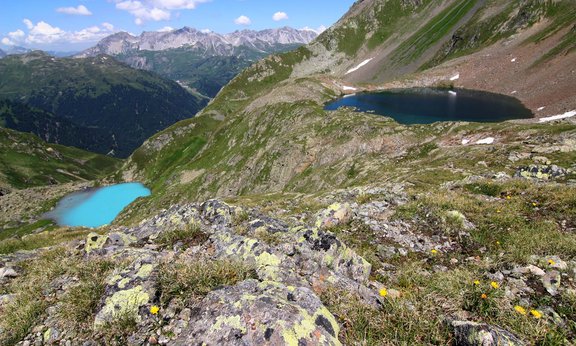Climate change causes the global retreat of glaciers, which have been recognized as habitats to diverse and active microbial communities. The aim of Ruben Sommaruga and Hannes Peter was to investigate the diversity and functioning of bacterial communities in lakes and their alterations in the course of glacier retreat. The two researchers have been studying the Faselfad lakes in the Verwall valley near the alpine Austrian town St. Anton for some time. “When glaciers completely disappear, the turbid glacier-fed lakes turn clear, which represents a potential bottleneck for established local organisms with yet unknown functional consequences,” explains Sommaruga, stressing the fact that the shift from turbid to clear lakes could happen, from a geological point of view, in a very short period of time. Sommaruga und Peter’s study is the first of its kinds to investigate how bacterial communities in glacial catchments are influenced by glacier retreat.
Community functioning and consequences
“Glacier-fed alpine lakes and lakes that are not fed by glacial run-off differ in basic environmental conditions such as temperature, nutrients or turbidity,” says Sommaruga. Contrary to their hypothesis the scientists found that diversity decreases during the shift from turbid to clear lakes. “Although the turbid lakes are colder and primary production – the production of biomass through photosynthesis – is decreased, diversity significantly decreases along the turbidity gradient,” explains the ecologist. Many organisms encounter unfavorable conditions in the changed environment. Direct UV radiation, which penetrates clear lakes deeper causing UV stress, may make the clear lakes inhospitable for some microorganisms. Even though these altered conditions lead to habitat loss for many organisms, multifunctional diversity increases in the clear lakes. “We also studied what happens with community functioning in the different lakes. While some microorganisms disappear, primary production increase since light availability is not limited anymore. At the same time the diversity of dissolved organic carbon in the water increases, which is beneficial to the bacteria.” As diversity changes, the bacterial community functioning in the lake changes as well. Microorganisms that are found in clear lakes may assume at least some of the the functions of taxa that disappeared in the transition. Sommaruga and Peter want to investigate these changes in a long-term study: “It is very important to understand which taxa can survive the alterations and which ones will disappear. As the glacial ice mass changes rapidly because of climate change our studies become more and more relevant.” Microorganisms and bacteria in particular drive and control the biogeochemical cycling of carbon and nutrients in the ecosystem. “They influence the metabolism of the lake and control how much carbon can be absorbed by primary producers and how much CO2 will be released back into the atmosphere. A change in the type and amount of the organisms in the lake affects the whole carbon cycle,” explains the scientist. For two years now the IPCC has also pointed to the importance of the functions of lakes and rivers in the global carbon cycle because bacteria, forming the base of lake foodwebs, are responsible for how much CO2 remains in the ecosystem and how much is released into the atmosphere. Glacier retreat, the transition from turbid to clear lakes and the alterations and functioning of microorganisms are not only influenced by climate change but also affect climate conditions.

